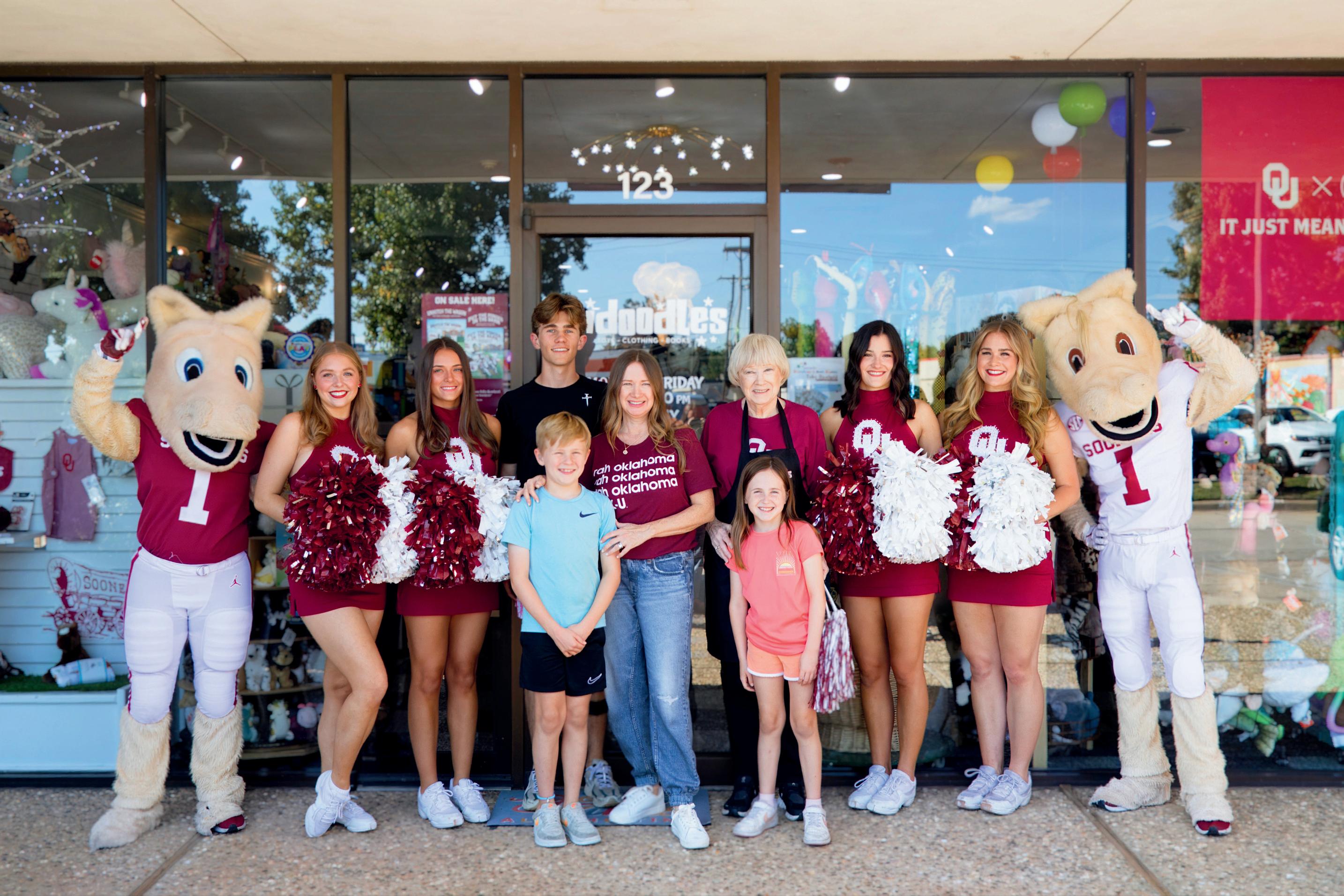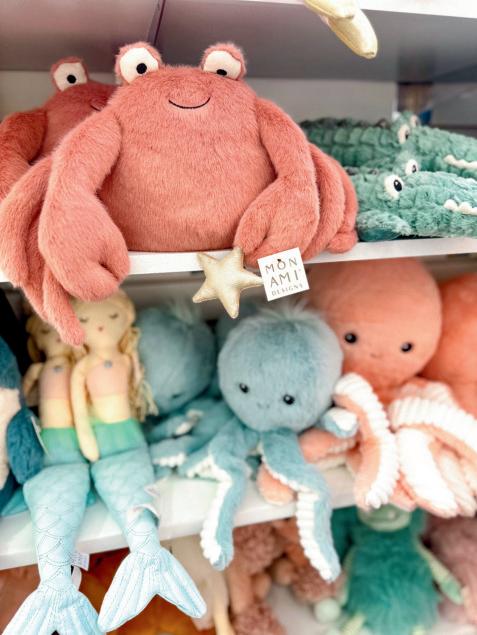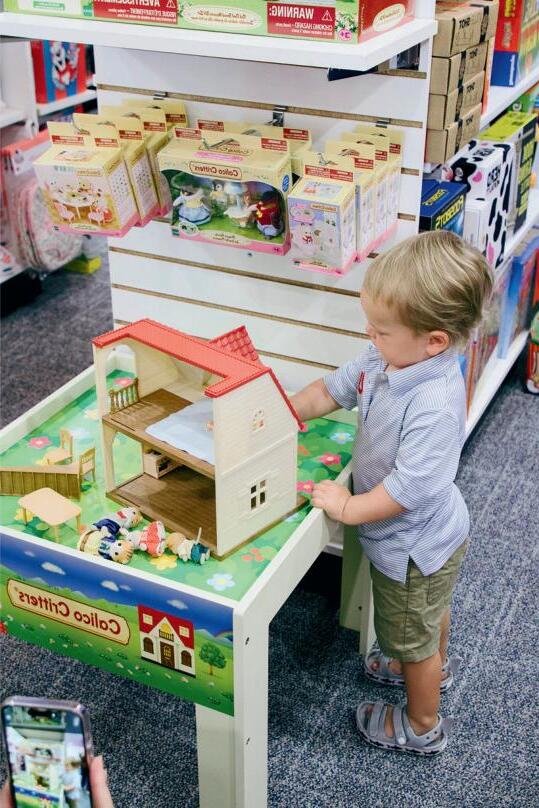




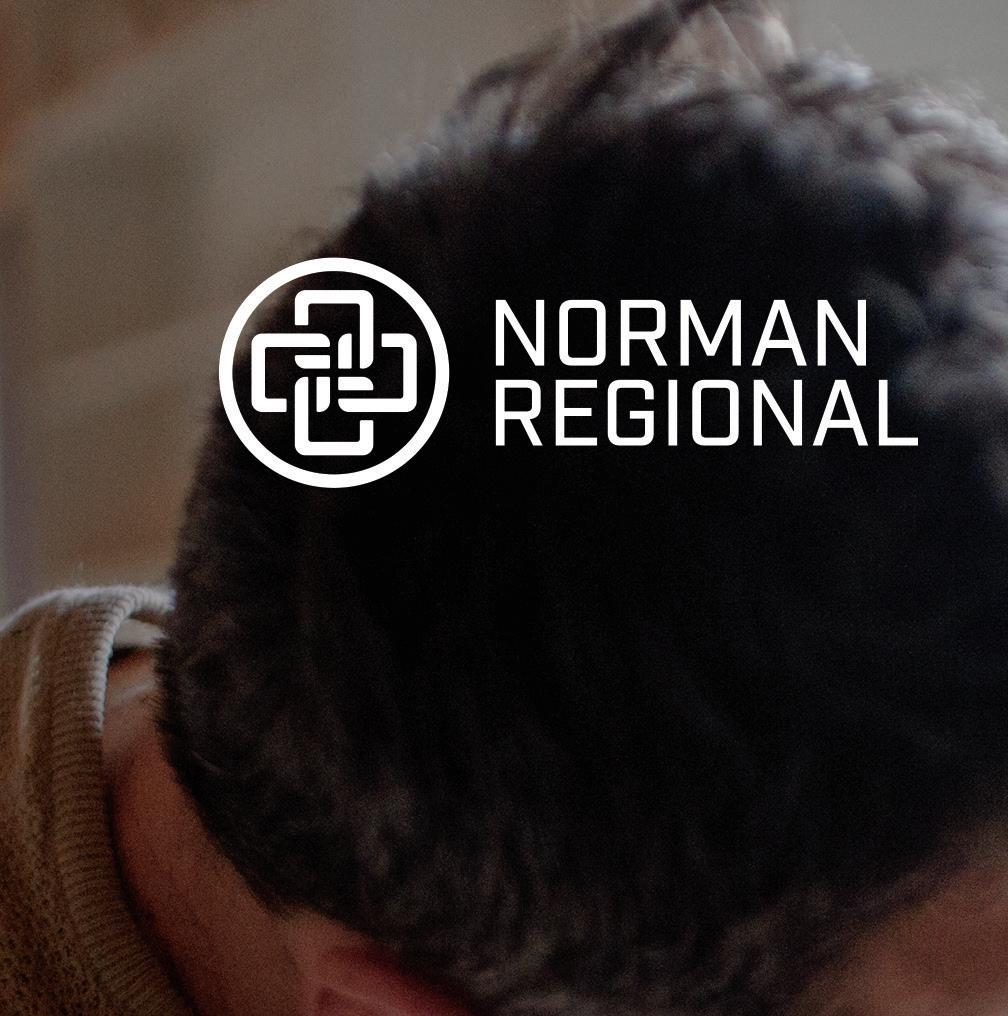

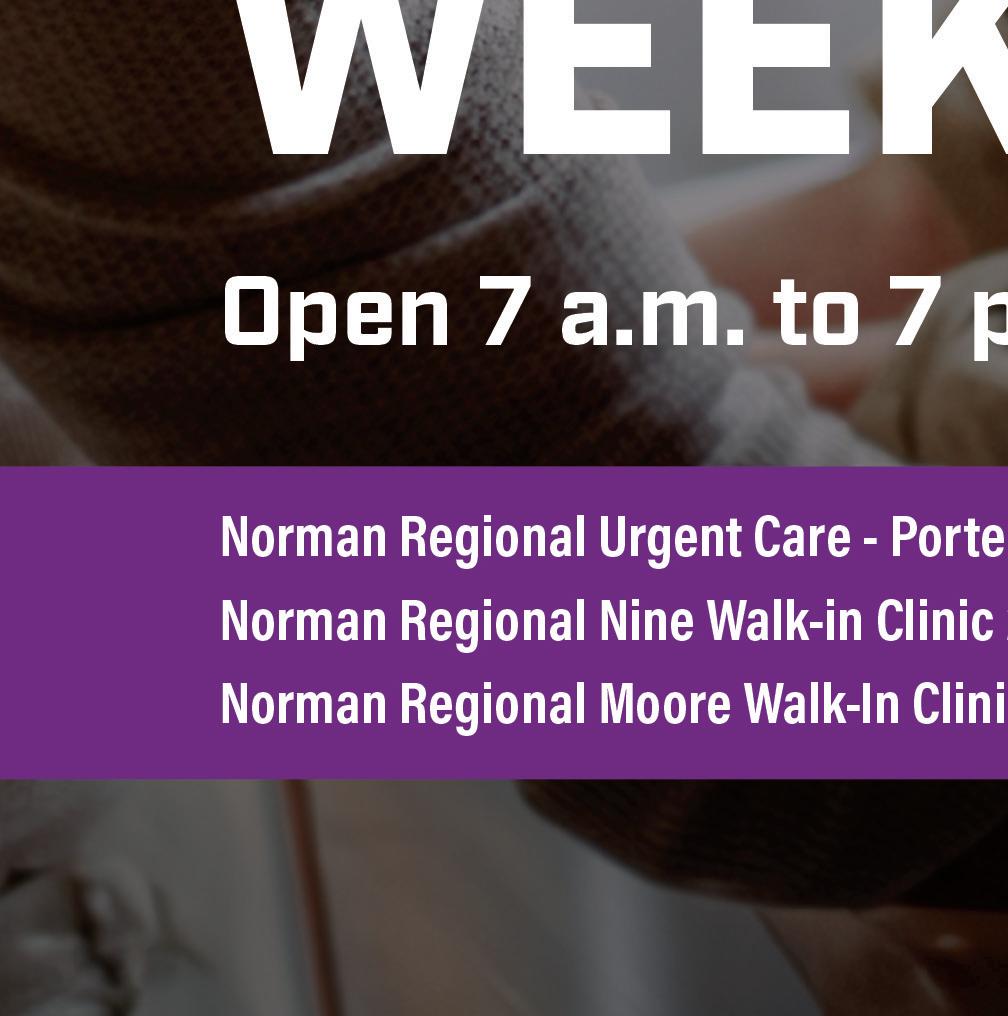











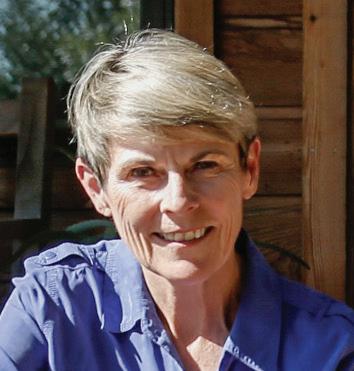


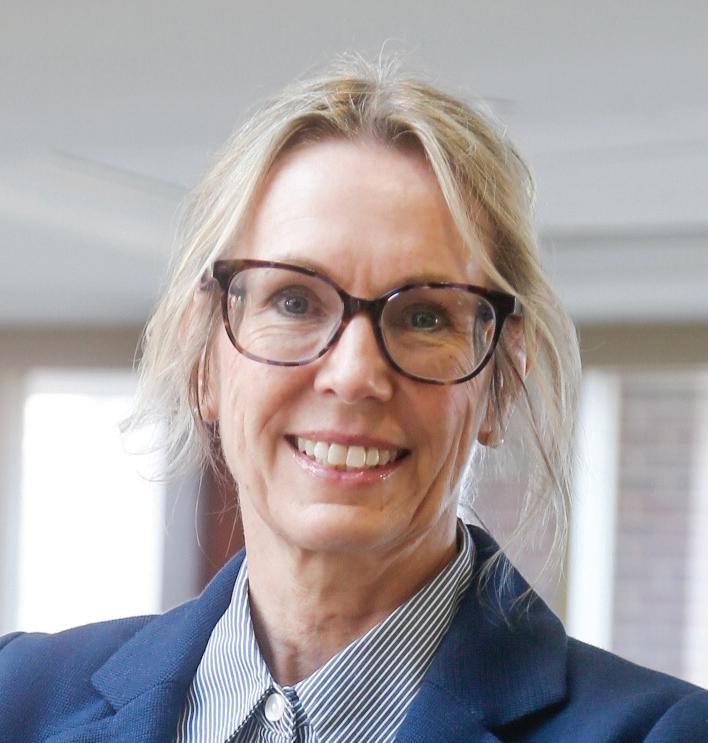



In this edition, the staff of Norman Magazine is doing one of my favorite things — highlighting incredible women thriving in their careers and creating an impact.
So many industries have been maledominated for decades — journalism included — and as a 26-year-old just making a name for herself in journalism and covering Division I athletics, it’s not uncommon to be the only woman in a room full of men.
According to the Pew Research Center, 46% of all journalists are women but when broken down into topic areas, only 15% of sports reporters are women.
So it’s inspiring to see women like Andrea Miller, who was recently named the first female dean of Gaylord College of Journalism Mass Communications, and Traci Bates, owner of helicopter training school Semper Fly, make a name for themselves.
As you travel through the pages of this magazine, you’ll learn about eleven women from the Norman community who may work in different fields but have similarities — providing for and improving the community and state they live in. Sooner Theatre PR and Development Director Nancy Coggins loves that the theater provides a place for children to try new things in a safe, nonjudgmental environment. Elizabeth McKinney, interim director for Startup405, is actively working to create a business incubator to promote young or new entrepreneurs and bring them into Cleveland County and Oklahoma.
Though much of author Susan Dragoo’s work focuses on a historical trail, she’s using her research and knowledge to help develop the Butterfield Overland Trail in Oklahoma with the National Park Service. On our cover, Nina Shuman walks readers through the history of her family’s beloved barbecue restaurant and how she and her brother are carrying on the legacy.
The accomplishments the women in this magazine have achieved are hard to summarize in a single sentence. So, turn the page and give their stories a read — they are truly inspiring.


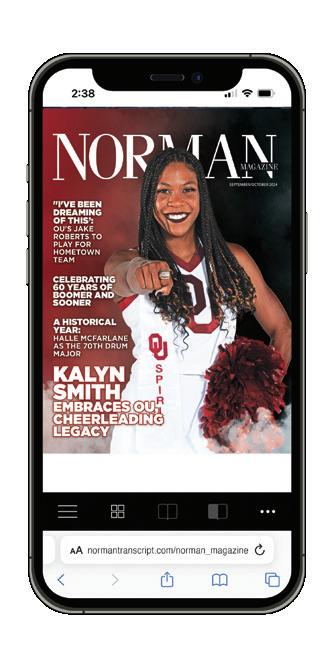





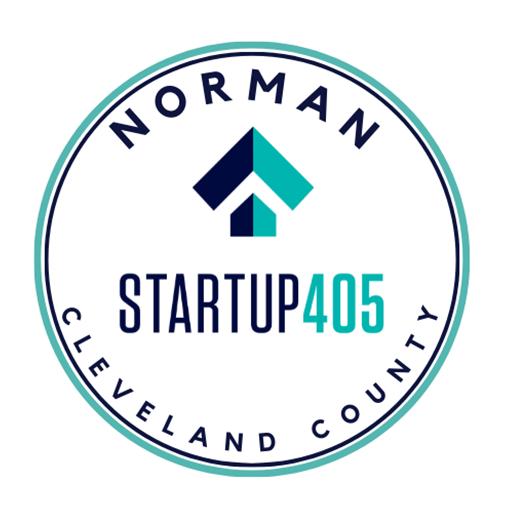



• CEO, Xyant Services • WomenExecson Boards, Executive Committee
• Boyd Street Ventures, Board of Directors • Harvard Business School


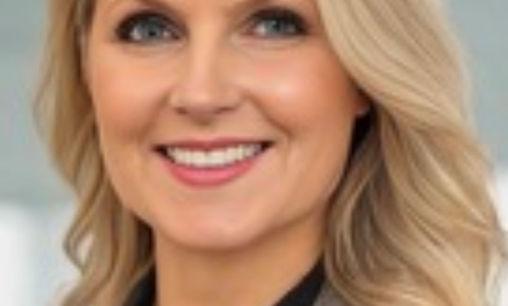



Boyd Street Ventures, Board of Directors
By Zack Wright
From teaching to parenting and now managing an entertainment center with her husband, Tracy Bates has worn many hats throughout her career.
Bates began her career as a teacher but soon left education after a couple of years to raise her children at home while also supporting the family’s HeyDay entertainment business parttime. After 18 years as a stay-at-home mom, Bates returned to the classroom in 2014.
“I went back to teaching and taught high school English at Norman North for eight years,” Bates said. “I made it through COVID, got on the other side of COVID and saw those students graduate.”
However, despite the connections she made returning to the classroom, Bates decided to take her skills and put them to use full-time as the Chief Operating Officer at Norman’s HeyDay location. Alongside her husband, the two now oversee 187 employees between their three locations in Norman, Oklahoma City, and Denison, Texas.
“I oversee the training, HR, and the culture — a lot of the same things you do with high school kids, especially teaching English,” she said. “It’s the same set of skills… back then I was writing curriculum in the classroom, but now I just write the curriculum and establish procedures here at HeyDay.”
Although Bates loves working with her different teams to solve problems as they arise, there are quite a few challenges that come with owning and operating a family business. And, at times, these problems can be amplified when the

lines between home and work are blurred.
“The biggest challenge was when I went from teaching, which had nothing to do with our family business or my husband and kids because our kids have all worked at Hay Day at some point,” Bates said. “Sometimes I’m Tracy, sometimes I’m mom and sometimes I’m Mrs. Bates. We’ve kind of learned as those relationships evolved over time — we call it separation at church and state.”
Due to her previous influence in the community as a high school teacher, the perception problems didn’t just affect her familial life — Bates had to work to change her image and perception amongst former students and colleagues, as well.
“It was difficult to change others’ perception of me… people knew me as Reagan’s mom or Trey’s wife, so I had to get people to not see me as a teacher or a mom, but as this leader here at HeyDay,” Bates said. “I had to really establish my credibility and use those classroom and life skills to not just lead, but help everybody else under me to grow and develop.”
Bates has now cemented herself in the community as a strong businesswoman. The COO said one of her biggest accomplishments was overseeing the Norman location’s expansion, which ultimately led to an award from the International Association of Amusement Parks and Attractions recognizing the family’s business as one of the world’s best family entertainment centers.
The business also has a big impact on surrounding communities and families. Bates didn’t only recognize her role in the community
and how important HeyDay can be to residents seeking fun and entertainment but said it was one of her favorite parts of the job.
“The thing I feel best about is the impact that HeyDay has on our communities,” Bates said, adding, “It’s in our mission statement — we strive to provide an excellent dining and entertainment experience, have a positive impact in the community that we are in, and then also provide a set of core values for our employees to live by.”
But, as Bates will tell you, making a name for herself and an impact on her community wasn’t easy, and she couldn’t have done it without seeing it firsthand for herself through her mother. And, on a professional level, author and podcaster Brené Brown has encouraged her and given her the inspiration she needs to guide and lead those under her supervision.
“[My mom] was a single mom who went back to school, and her career really took off soon after,” Bates said. “She just became so wellknown and well-respected for her knowledge and expertise in public education… she’s 83, so she kind of had to break that glass ceiling in politics and education.
“But Brené Brown is probably my scholastic, academic person I default to in terms of being a leader,” Bates said, adding, “She has been a driving force behind me speaking up about things I consider to be right or wrong. Both of these women are part of the success I experienced as a mother, teacher and now as an executive and owner.”
As for the future, Bates hopes to open more HeyDays but is prioritizing perfection at their current locations while waiting for the right opportunity to arise. Bates is also currently working towards creating and selling online courses to those who wish to succeed in business the same way she did.
“I’d like to marry all of my different skill sets and really apply my expertise as an educator and manager through these courses so others can learn from my mistakes,” Bates said.
No matter what the future holds or where a potential new entertainment center may be located, the Bates will never shake the small, family-owned business values they hold paramount.
“We’re in a 40,000 square foot building, but at the end of the day, this is a small, family-owned business… when somebody needs something, whether their house floods or they’re behind a paycheck, we can easily meet those needs,” Bates said. “We’re able to help our employees and people in our community, and I think that’s a really powerful thing for us as a family to do for people who need it.”



By Ben Fenwick
For Nina Shuman, Van’s Pig Stand is not just a restaurant, it’s her family’s history handed down to her; where she bussed tables for $3.25 an hour when she was a teenager, and now, where she is carrying forward that legacy.
“I worked in the restaurant when I was a kid,” she muses. “And here I am twenty-something years later.”
“Later” for Nina means managing Oklahoma’s oldest family-run barbecue restaurant, alongside her brother, Jev Vandegrift, and her husband, Mark Shuman, who started as a cook for Nina’s dad in Shawnee. It also means carrying forward that legacy in a business normally populated by men.
“I am on the Oklahoma Restaurant Association board and have been a long time, over ten years,” she said. “There are not a lot of women on the board. It is mostly men. There are only a handful of women.”
Nevertheless, she said, she is treated with respect in such situations.
“I feel like the role that I have, there is a lot of respect. Now there are a lot of women who run businesses successfully and the roles between men and women have shifted.”
Being forward-thinking runs in the family. Next year, Van’s turns 95. When Van’s Pig Stand started in 1928, there was no Interstate System. The only way to travel across the state east to west was one US Highway that ran through Wewoka, right past the location where Tennessee native Leroy “Van” Vandegrift had his first sandwich stand, selling pork sandwiches.
In those days, Van’s Pig Stand was just that — a squat, low building with a counter that had an awning over it… just a sandwich stand along the

highway.
Well, something stuck. Perhaps it was those sandwiches sticking to the ribs of the travelers, but business picked up. Van moved his restaurant to a building in Shawnee, running the business there while he built the one that eventually became the cornerstone of the brand in 1935: 717 E Highland St., Shawnee. He also met and married Thelma Maree Glenn, at which point they didn’t just grow a beloved restaurant brand; they created a dynasty.
“I can’t imagine how my grandmother did all that,” Nina said “She did all that while raising the family.”
Nina said her grandfather and grandmother passed away in the 1970s, leaving everything to her father and his brothers; however, her father, Jerry E. Vandegrift, was the only one who stayed in the business. When Jerry passed away in 2023, he in turn left everything to Nina and her brother.
“He left everything to us and we choose to work together rather than buying each other out,” Schuman said. “Since my brother and I and my husband started in 2000 — nearly 25 years ago — we started opening a few more stores.”
In 1994, the eighth Van’s Pig Stand opened in Norman, 320 N Porter, on November 5th, with Jev Vandegrift as manager. Nina was there.
“The store in Norman opened on a football Saturday — which is crazy,” Nina said. “I think it was Alabama. They ran out of ribs, shut the store down, and reopened when they were able to get more product in.”
Then the openings came fast. In 2003, they opened a second Van’s in Shawnee, and in 2005, one in Moore. While a few other locations have come and gone, Van’s opened its 12th restaurant
in Purcell in 2016.
Of course, like all family sagas in Oklahoma, sooner or later you have a tornado.
“We were on 4th Street (in Moore) in the old Mr. Burger building and we lost it in the tornado in 2013,” Shuman said.
The old Moore Van’s was directly in the path of the May 20, 2013 tornado that ripped through Moore. The EF5 tornado killed 24 and injured more than 200 others. Despite the building suffering irreparable damage, none of the employees present in the building at the time were injured.
“Fortunately, we had already purchased the land at 19th and Tower. While it was very hard and tragic, fortunately for us, we reopened the Moore store in its new location in 2014,” Nina said.
In 2014, Nina and Van’s held a ribbon cutting and a “rib” cutting to welcome the town back to its restaurant.
“We want to have fun and celebrate the fact that we’re here, we’re back and we’re Moore Strong,” Nina told the Transcript at the time.
Nina said that expanding outward has slowed some, mostly to solidify the business and work on organizing the operations “on the back end.” Nina said she has two strong partners in her brother and husband, and still works in the stores. For instance, she makes the secret family recipe for both Ice Cream Pie and Rum Pie.
“I still go into the Norman store and I make the family secret Rum Pie. We do the Ice Cream Pie in Moore,” she said. “We have a few things that are a trade secret. Some of those recipes we don’t share and those are two of them.”
As she travels into the future with Van’s, Nina is carrying her family’s tradition forward with her. But her business also has to meet the future challenges head-on.
“We have longevity and brand recognition. But we can’t just ride on the coattails of my grandparents and do what they did and stay relevant,” she said. “We do all the delivery services, DoorDash and Uber Eats. We have online ordering. We do a lot of catering, especially during football season.”
And yet, being relevant doesn’t mean leaving the past behind or for instance, the ingredients.
“Everything is made in-house,” she said. “Our pies and cakes are made in-house. We make our own rub, we make our baked beans, we make our coleslaw. It’s all made in-house, It’s a challenge.”
And yet, looking back, she sees how far she and her family have come.
“I found my grandfather’s tax returns from 1930 that says Van’s Pig Stand,” she said. “I framed it and put it in the office. He made a thousand dollars that year selling 15-cent sandwiches.”





















By Archiebald Browne
Brandi Rector was once told during deployment in the Marine Corps in 2009 that she needed to work twice as hard to get half as far as the men around her. That statement has stuck with her ever since.
Now, Rector is proud to say she has worked hard enough to set a standard and a pathway for women pilots in an industry with low representation.
Rector is the founder and CEO of Semper Fly Helicopters, a helicopter flight school located at the Max Westheimer Airport. She began Semper Fly Helicopters in 2022 in Broken Bow as a tour company.
After inquiries about partnering with the University of Oklahoma for a helicopter flight school, Rector decided the opportunity couldn’t be passed up. The flight school opened its headquarters in July 2024.
“The industry is hurting. There is a shortage of pilot helicopter pilots. Flight schools suck. They take money and the students come out with like, no idea what to do,” Rector said. “There’s no pathway to get anywhere. There’s a big gap between leaving flight school and getting a real job as a helicopter pilot, and nobody helps you. We can make a change
and we can fix that.”
Rector said Semper Fly Helicopters has received recognition from all over the state, hoping to grow into something more.
“We’re talking already about expansion and how welcomed in that we’ve been with the city and the county and the state,” Rector said. “And then even outside of this, other states are looking at us now and what we’re doing and it just makes me feel like I’m setting a new standard, like I’m setting a new example.”
Rector said she is proud of what Semper Fly Helicopters has accomplished.
Rector was a mechanic and door gunner in the Marine Corps until 2014. She said it is one of the hardest things she’s ever done in terms of acceptance as a woman.
“Being a mechanic in the Marine Corps is harder than anything I’ve ever done, as far as acceptance and being treated badly because they can get away with it. They can do whatever they want to you, and you can’t just quit,” Rector said. “But out in the civilian world, I think it’s 10 times better than the Marine Corps ever was.”
She earned her helicopter pilot license after military service. Rector said she had an easier time being a civilian pilot, but
said women who aspire to be pilots still go through rough times in flight school.
Rector said discrimination of any kind is not tolerated at Semper Fly Helicopters.
“We have to be different, and we have to let them know that it’s not going to be tolerated here,” Rector said.
Rector said women in this industry are a minority and it could take one screw-up by one person for others to look at all women differently.
“Because all it takes is one female can screw something up in an industry where you’re a minority and then they look at all of you the same,” Rector said. “They’re like, ‘Ah, females suck. I don’t want to work with her.’ You could be amazing but (that) doesn’t matter because one of you sucked, and one of you did something dumb.”
Rector believes having women stick together and build each other up will be key.
“I feel like, if we can keep raising the bar, then we’ll make all the females that come after us... their lives are going to be better because they’re like, ‘Hey, she did it like and she’s killing it...” Rector said. “So that’s what I’m hoping for, is that it opens up the doors for the ones to come behind.”

By Archiebald Browne
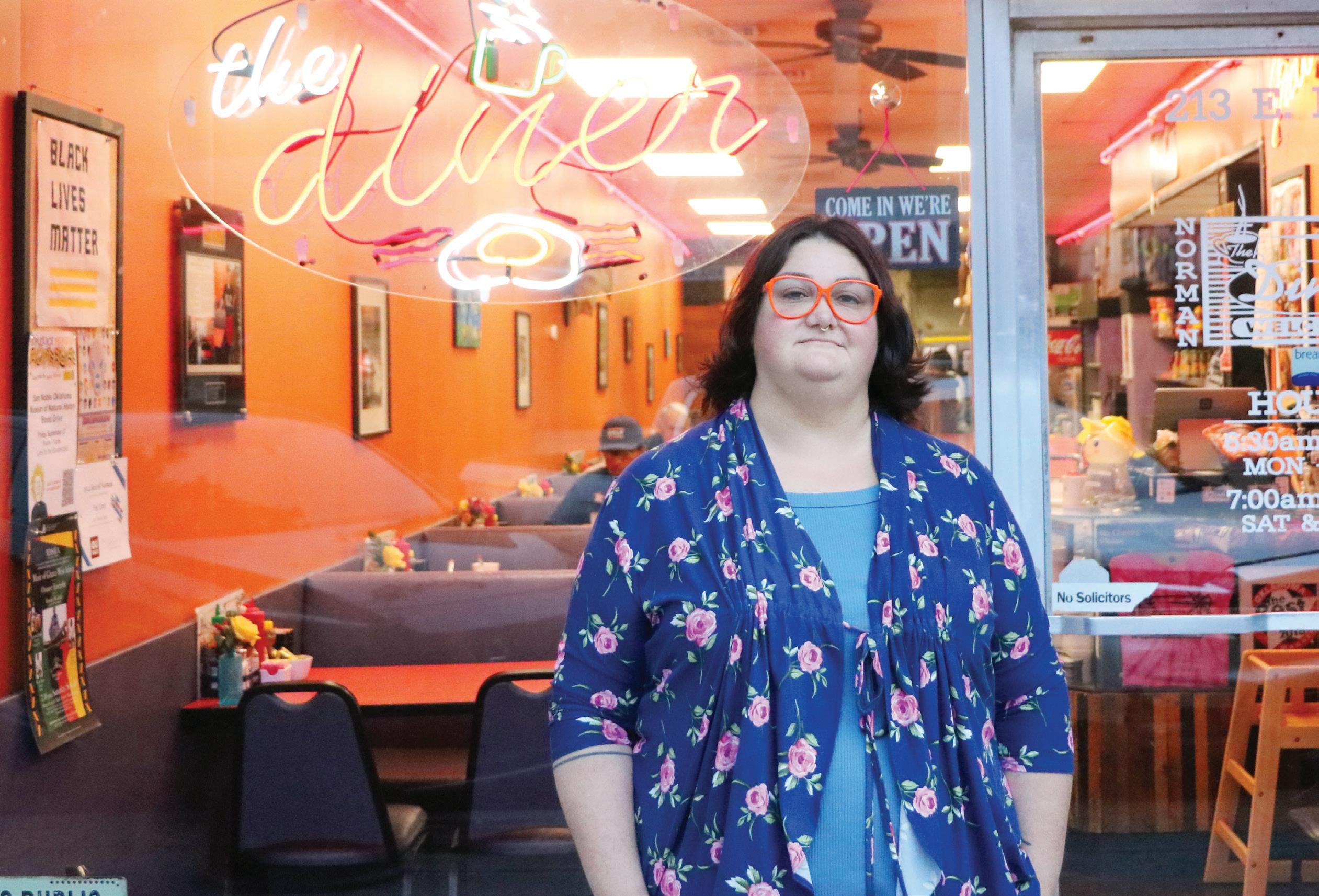
BBonnie Amspacher’s family has a long history in Norman.
Her family owned a grocery store called The Southside Grocery on Lindsay Street that closed in the 90s. Her father, Mark, opened The Diner in 1889.
She had observed his work with the restaurant growing up, always having an interest.
When Amspacher’s father’s health began to decline, she stepped in and started doing what she felt needed to be done. When he passed away, she took it over completely.
“I came into it the family way, but I do sometimes think about the differences and the challenges that I saw him face, and what I face, and there’s subtle differences.”
But Amspacher tries to not think about the differences much now, over a decade after taking over. Now she can say she is a respected woman business owner in Norman.
“I feel like I haven’t always been fully aware of my position in the community, where I’m just like, ‘I’m just doing my thing. I’m just cooking eggs,’” Amspacher said. “And then people are like, ‘Oh, it’s so cool that you do this.’”
As a woman business owner, Asmpacher said to not be intimidated and take it one step at a time.
“I think it’s been a lot of hard work, but also a lot of luck and happenstance and everything’s just come together for The Diner to be able to be what it is,” Amspacher said. “I don’t take full credit for it, but I have put a lot of work in it.”
The Diner means a lot to the Norman community, Amspacher said.
“I think The Diner does mean a lot to a lot of people, and it’s cool to be able to curate and provide that space for the community to have a meaningful and interesting place to come,” Amspacher said.
Amspacher said she plans on keeping
The Diner nostalgic with its famous chili and atmosphere.
“It’s not just like Denny’s, so that feels pretty cool to be able to carry it on, because it’s like a new, cool place for a lot of younger people or people who are just discovering it. It’s also really nostalgic for a lot of people who come in and they’re like, ‘I’ve been eating here longer than you’ve been alive,’” Amspacher said. “This has been a diner forever. I’m glad we’re still here.”
Amspacher said she is most proud of the recipes that have lasted all of these years and the employees.
“It’s the same chili and stuff that people could have gotten at the grocery store a long time ago,” Amspacher said. “I try very hard to treat my employees like people, and I’m proud of that. I mean things aren’t always 100% smooth, but I think that my staff does a really good job, and I’m really proud of them.”






















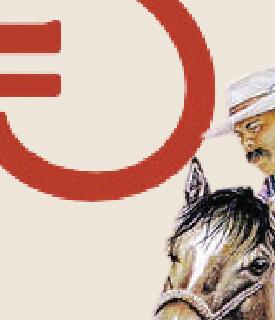




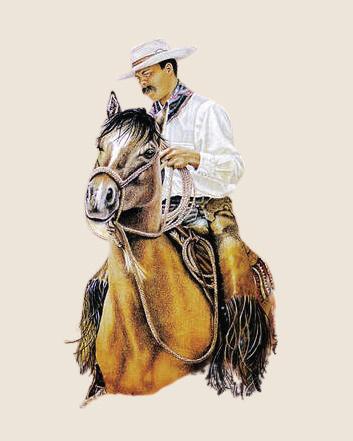

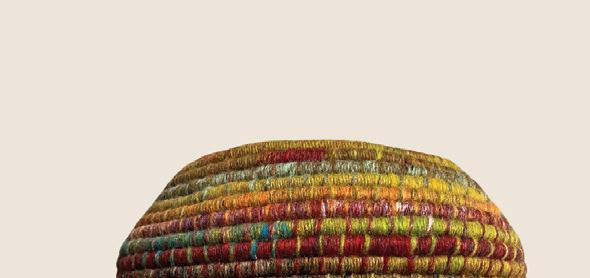
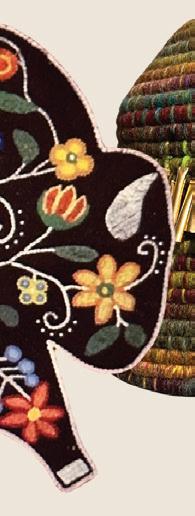

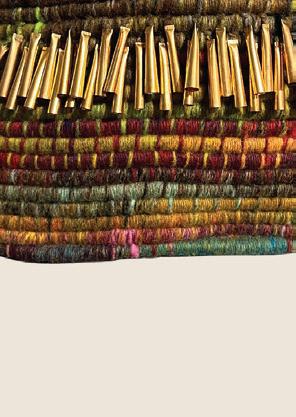














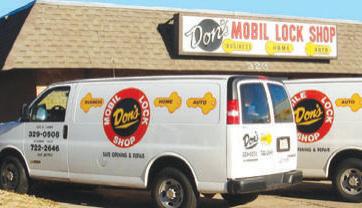




















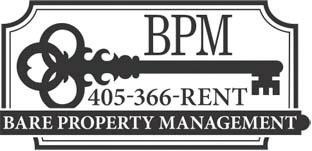






















By Archiebald Browne

Once Emily Claudé graduated college from the University of Oklahoma, she needed to try a new environment.
Growing up in Norman, she moved to Boston after college, where she said she had a great experience. When she moved back to Oklahoma and started working at Oklahoma Arts Institute in 2005, she realized she had taken several things for granted.
“I realize now, of course, as an adult, how fortunate I am that I got to grow up in this town that afforded me so many different opportunities to explore so many different areas and to be a part of Norman Public Schools,” Claudé said. “You know, looking back on it now, I realize I was taking college-level classes in school and getting this accelerated education, which really, I think, set me up for success in life later.”
Once Claudé started working for OAI, her eyes opened to a new community of artists, art supporters and arts educators.
“And I fell in love, and I knew that this was the thing that I was meant to do,” Claudé said. “And I just feel so fortunate and honored that I have been given the opportunity to do this for as long as I
have.”
Claudé is the co-vice president and director of programs at Oklahoma Arts Institute. Her main duties are overseeing the programs and hiring the faculty that come and teach.
She has learned that there is always room for improvement in her position.
“I honestly believe that that is the reason for our success and our longevity, is that we are always trying to make this program better. And that’s the thing that makes my program, my job, so exciting, is that it’s never boring. It’s never the same, even though the programs happen like clockwork, year after year, this job is very cyclical in a lot of ways,” Claudé said. “We’re always doing something different. You know, we’re always looking for ways that we can make this program better.”
Claudé said she sees herself as a work in progress. She also sees the programs as an extension of herself and relishes the opportunity to make improvements to OAI’s programs.
“It’s fun for me to try to figure out how to implement those improvements. That’s what’s made my job interesting over the years,” Claudé said. “And then, of course,
we have this incredible group of staff that work with this program.”
Claudé said it is important to remember that the arts are what makes us human.
It connects us in a way that nothing else can. It makes us feel and empathize with each other,” Claudé said. “The arts, I think, in particular, with young people you know, the high school students that we serve every summer at Quartz Mountain, it gives them an outlet for self-expression that is not only healthy, but I think, vital for students that age.”
Claudé said she takes pride in bringing in faculty that has the chance to make a difference in the lives of the students that come through OAI.
“The faculty that we bring in to teach them has that rare opportunity to shape the leaders of the future. I just feel so honored that I have a small part in bringing in those faculty that get to have that experience with those students,” Claudé said. “I really believe in the power of young people to change our world in the future and to get to be a small part of that is such a privilege.”

NNancy Coggins has always loved the theatre.
By Paxson Haws
She has been active in the theatre world since high school, either by being in productions herself or through her children. For the past 13 years, she’s been directly involved in Norman’s theatre community as the public relations and development director for Sooner Theatre.
Coggins worked at the Oklahoma National Memorial and Museum and the Science Museum Oklahoma before going to Sooner Theatre. She said her children were active in the Oklahoma Children’s Theatre as she was in the city so often.
“I was a working parent and it was difficult,” Coggins said. “My oldest daughter did a class (at Sooner Theatre) in the evenings, but during the summer and stuff, I was still in Oklahoma City.”
Over time, Coggins became more involved in Sooner Theatre by being a parent volunteer. She said Jennifer Baker, executive director of Sooner Theatre, was constantly trying to convince Coggins to work for the theater.
“We kind of re-kindled our friendship because our daughters are the very same age, and they went to school together all through, and they were friends. So, Jennifer always made a joke that she was gonna get me here. I was like, ‘You can’t afford me,” Coggins joked.
But in 2009, Coggins said she lost her job during the recession and in 2011, officially decided to join the staff at Sooner Theatre.
Her official title is public relations and development director but with such a small staff, she does a little of everything. She helps

sell tickets, fundraise, answer the phone, write grants, advertise, and sometimes even plunge the toilet. She’s the default IT person as the theater doesn’t have an IT department and she helps find props and searches for costumes.
Comparing the jobs she’s had in various fields, and taking a pay cut to work with Sooner Theatre, Coggins said she feels that creative spaces and nonprofits have more equality within the workforce. She’s experienced previous superiors trying to pay individuals more than Coggins when the individuals worked under her. But in other jobs — including the Memorial and Sooner Theatre — Coggins said she’s worked with incredibly strong women.
“I love my job. I love this theater. I believe in our mission,” Coggins said. “I know what theater did for me as a kid and I am so grateful that I get to be a part of doing that...providing kids with a safe space where they can find their voice and be crazy, kooky characters and be cheered on for that.”
The theater puts on two community productions, a couple of fundraising productions, and seven youth productions each year, on top of the 55 classes held yearround. There are several “crazy talented kids” who participate in the classes and productions, according to Coggins, but there are also some who walk through the theater doors and can barely look someone in the eye.
“Then like three years later you turn around and they are in the center of that stage belting out a solo in front of a sold-out audience and it’s amazing,” she said. “It’s amazing. They may not ever be on Broadway, that may not be
what they want to do. They may want to be an aerospace engineer… but watching them grow through that and watching their confidence grow and watching their cute little quirky selves become these confident, stage veterans is awesome. It’s an amazing thing to watch.”
Coggins said Sooner Theatre never wants to turn any interested student away from the provided programs, which is why fundraising and community support are important to the theater. Last year, the theatre gave out over $61,000 in scholarships, Coggins said.
The theater is a great place for children to learn “soft skills” like creative thinking, Coggins said, using a stage partner forgetting their lines as an example.
“There’s the skill of thinking on your feet, which is a great skill, but the secondary skill in that is learning how to cope with change, something that’s not the same,” she said. “… that we have a place that is safe for them to be the one that messes up or be the one that saves the day — either way — and nothing is a failure. We just move on and we move through it and we learn through it. You can’t teach that skill in a math class.”
Coggins loves her jobs, her co-workers, the students, and the impact Sooner Theatre has on the community, but there is one job that outshines all others.
“If you ask me what my most important job was, it would always be Mom,” Coggins said. “My career is great and I appreciate it and I appreciate that I have it… I’ve had some really amazing experiences in my life, in my career, but they pale in comparison to getting to watch my girls do their thing.”



By Paxson Haws
Elizaberth McKinney has done it all.
She’s a U.S. Army veteran, a former school psychologist, a “serial entrepreneur” and a small business owner.
“I’ve always been driven to be a helper, to create positive change, particularly for women and young adults,” McKinney said.
Today, she serves as the interim director for Startup405, the third state-certified business incubator with the Norman Economic Development Coalition. A business incubator is an organization focused on helping startup companies and entrepreneurs develop their business by providing various services. With Startup405, it will also offer businesses the opportunity to rent out coworking and office space next year at its new location, 425 West Main.
“With entrepreneurship being one of our key strategic priorities, we are very excited about the expansion of our programming, forming strategic partnerships and renovating our future location.”
McKinney took over the role of interim director in May but has been helping refine and implement NEDC’s strategic direction and its funding model for the past several years. Her days typically include activities used to foster transformations, growth and identifying collaboration opportunities — though that doesn’t come without challenge, especially in a role that is focused on making changes in the community and individuals’ lives. She said it requires patience and perseverance.

“Resistance to change is a typical human response to anything that alters the current status quo.,” McKinney said. “There are a multitude of reasons for this, but a lack of understanding of the purpose and uncertainty about the future are common. When communities or organizations determine the need for a new strategic direction, aligned leadership and communication of the vision are crucial.”
So, interacting with community members, stakeholders, public officials and various organizations is vital to her position because some issues facing the community and its people today are “too big” for one organization or entity to solve on its own.
She wants the community to know that she believes the future of Startup405 is focused on collaboration, partnerships, and engagement — that the business incubator’s vision is to provide a workspace for business and be a catalyst for innovation and create growth that attracts talents, capital and opportunities to Cleveland County and the state as a whole.
Though there have been challenges in her position, while building Startup405 and at other times in her life, McKinney said she views them as opportunities for growth. She said she’s learned to embrace change, continuously educate herself, and move forward “no matter what.”
“In life and the entrepreneurial world, resilience is key,” she said.
And resilience is not something McKinney
is lacking.
She served in the Army’s First Calvary Division, ran several small businesses, and was a first-generation college graduate. Throughout her career, she’s raised $40 million for non-profits — $8 million of that (and counting) in Norman.
Her mother’s commitment to the family, work ethic, unselfishness and “never-ending” faith is something that has inspired McKinney throughout her career. Her children and husband, Lawerence, who she’s owned a consulting business with and worked with daily for the past 10 years, also provide an abundance of inspiration.
“I’ve shown (my children) that with determination and hard work, any goal is achievable,” she said,
McKinney and her husband are emptynesters now and she’s filled most of that newfound free time with community work. She engages in community service organizations as s board member, committee member or volunteer, partially with United Way. But when she does have a few spare moments, she spends them reading and traveling to Florida and Tennessee to visit their children.
“What the future holds is hard to say,” she said. “Helping communities like we do, meeting some of the brightest young talent and bighearted community leaders, and becoming true friends is a lasting legacy that can’t be topped. I love what I do and don’t plan to stop anytime soon.”



By Zack Wright

Although many begin to settle down after retiring, life’s adventures have only begun for author and avid adventurer Susan Dragoo as she pursues one of her foremost passions: documenting her adventures and historical discoveries made all across the United States.
After 35 years working in the administrative side of healthcare, in 2014, Dragoo retired from her position as the Vice President of Quality at Integris Health. Despite a few short stints as a quality consultant, the former administrator has made quite a name for herself as an author.
However, writing was nothing new for Dragoo. As a graduate of The University of Tulsa with a journalism degree, she began her career working at her local newspaper. She picked up the hobby years later as a part-time contributor at various outdoor magazines and historical journals, including Oklahoma Today.
“The majority of my career was in healthcare, but fortunately for me, I got to go back into doing really what I started out to do which is writing,” Dragoo said. “My husband and I wrote for motorcycle magazines for several years, and I really wanted to get into more historical work and other kinds of travel hiking magazines because I’m a backpacker and I wanted to do some writing about all of that.”
As Dragoo stated, the outdoors has always been a big passion of hers. Whether she’s riding motorcycles or four-wheelers, exploring slot canyons or hiking through uncharted territories, her desire to explore the unknown has fueled her writing career as of late.
“Recently, I’ve gotten really addicted to hiking in the Grand Canyon. In the last four years, I’ve done several trips down into the Grand Canyon — two backpacking trips, one rim-to-rim trip, another trip from rim to river to rim and I’m sure I’ll do another one next year,” Dragoo said. “I’ve written about those for an online magazine called Trail Groove, so
it’s probably my most prominent current hiking addiction, but I’ve also been to Iceland a couple of times.”
Despite her various adventures in the states and abroad, so far, Dragoo’s greatest achievement has been retracing and documenting the Butterfield Overland Mail stagecoach route — a mail route established in the 1850s that connected the East and West Coasts.
“Because I’m a history nerd, I spent time reading the Chronicles of Oklahoma, which is the journal of the Oklahoma Historical Society, and came across the Butterfield Overland Mail and realized that it was right in our own backyard here in southeastern Oklahoma and decided to write a magazine article about it,” Dragoo said.
After the first article fared well with her editors, Dragoo decided to report on the seemingly forgotten trail for other publications, too.
“As I got into it, I realized there were so many remnants of the trail that it was a pretty big story. Nothing had been written about it since the 1950s, and to me, this was a historical treasure that really needed to be documented, and it couldn’t be done within the context of a 1500-word magazine article,” Dragoo said.
What was originally just a project to document the trail and preserve the knowledge for others had grown into much more than the adventurous couple had bargained for. With years of research under her belt and so much to document, Dragoo broke from the word count confines and wrote her own book that thoroughly details her adventures retracing the trail.
According to Dragoo’s website, susandragoo.com, her book, “Finding the Butterfield: A Journey Through Time in Indian Territory”, guides readers “through the Choctaw and Chickasaw Nations, both in the late 1850s
as a passenger on the Butterfield Overland Mail stagecoach and in the 2020s as an explorer seeking the remnants of the old trail in presentday Oklahoma.”
Given her past success as a healthcare administrator and recent success as a writer, it’s easy to assume Dragoo faced many roadblocks on her way to success. And, although there were a few, the author claims she didn’t recognize or let any gender boundaries hinder her success.
“Growing up, going to college, and even as I started to work, I never really thought about the fact that I was a woman and that (my gender) could hold me back,” Dragoo said. “I did realize later in healthcare in the role that I was in that there’s a gradient, but it wasn’t necessarily gender related – it was more status related working for physicians as a staff person.
Dragoo said she did not find this to be the case in outdoor adventure journalism, but does see it some in the motorcycle riding world.
“I see women feeling like sometimes they have to prove themselves on a motorcycle more so than men because of their stature on taller motorcycles riding in tough terrain… sometimes it’s just getting them out of their own heads, but that’s true for some men as well.”
Although the explorer hasn’t faced much adversity due to her gender throughout her career, perhaps one of the more unexpected challenges Dragoo has faced has resulted in her success. She considers writing and publishing her book one of her greatest achievements, but the newfound author had no idea how tedious the publishing process would be.
“I researched this book for eight years and then I had to learn about the publishing process and go through all of that. It was just something that required a lot of determination,” Dragoo said. “I feel like that’s probably been one of my biggest achievements as a human being.”
With successful careers as both a writer

and administrator, it’s safe to say Dragoo has accomplished a great deal throughout her career. According to the author herself, she couldn’t have done it without the guidance, support and inspiration from her husband, Bill.
“My husband has probably been the most significant inspiration in my life since we got married, which will be 20 years next year,” Dragoo said. “We have just lived such a life of adventure… I would say he’s a possibility thinker — it’s always what can we do, where can we go and let’s just do it.”
Dragoo’s cornerstone throughout her life has been her faith. The author is very involved at Paradigm Church where she helps lead the women’s ministry.
“[Ministry] is actually something I devote a lot of time to, and my faith in Jesus is definitely my focal point in life,” Dragoo said.
Moving forward, Dragoo stated that she will work alongside the National Park Service to continue developing the Butterfield Overland Trail in her new position as President of the Oklahoma Chapter of the Butterfield National Historic Trail Association. She is also currently working to retrace Army Captain Randolph Marcy’s 1852 expedition to find the source of the Red River.
And when she’s not busy trekking old trailheads and preserving history for those to come after her, you can be sure Dragoo will be somewhere out in the world exploring, looking to make new discoveries and preserve the world’s forgotten stories.
“I’m going to Spain next month to a good part of the Camino de Santiago in the Portuguese part of the country, and then I’ll be going to Costa Rica with a friend from here in Norman to try to help her teach a field sketching workshop,” Dragoo said, adding, “So just overall, continuing to travel. And I’ll definitely get another Grand Canyon expedition in the books at some point.”



FBy Ben Fenwick
For Leslie Pate, providing the right space for quality Native American art is not about contracts; it’s about connection. For 42 years in the business with both her native clients and her customers, that means shaking hands for an agreement.
“A lot of galleries want contracts with the artists, but I’ve never done contracts,” Pate said. “I go by my word and a handshake and haven’t had any issues. I always put the artist first. We just have a mutual respect for each other.”
That down-to-earth, human sense is no accident. Looking at the span of art expressed in her business, Tribes Gallery at 512 West Main St., that humanity is expressed in the art there, and so is the land from which it springs. Like in the landscape “Cloud Beings” of Citizen Potawatomi artist Peter Paul Bruno, depicting the stone columns of the American Southwest; or the Trail of Tears depiction colored onto a presidential proclamation signed by Theodore Roosevelt, by Choctaw/Cherokee artist Paul Hacker — the land and the people in it are indivisible.
Pate said she got her degree in Geographic Information System, attending first at OU and finishing at UCO later. However, her real start came straight out of high school when she helped renowned art curator Doris Littrell at the Oklahoma Indian Art Gallery in southwest Oklahoma City.
“In 1983, when I was selling real estate, I
was helping out Doris with some shows. She loved what I did and offered me a six-year apprenticeship,” Pate said. “She taught me everything.
I’ve been working with these artists since then — a year out of high school. I’ve been doing this for 42 years.”
Although not a member of a tribe herself, Pate said she learned about cultural practices and the differences between tribes working at Littrell’s gallery, and what kinds of expectations artists have of those curating their artistic treasures.
“It’s about maintaining a good rapport with people and standing behind your word,” Pate said.
Eventually, Pate opened Tribes Gallery with her mother, Hannah, in downtown central Norman. They set up shop in a brick storefront and the two ran that gallery.
“We started out where the Garage is now, in 1990,” Pate said. “We were there for 17 years. Then my mother fully retired. I took a year off. I ran the gallery out of an office in my home and thought I would use my degree, which is in GIS.”
Although the discipline of GIS is about matching information to land, for Pate, the role came out differently. Offered a position in Washington, D.C., Pate made a momentous decision on which direction her life was going to take.
“I was a single mom and my daughter was

young,” Pate said. “I was a national geographer for the US Census, and I couldn’t justify taking her to D.C. They offered me a position, but I came back and opened the gallery on the westside and was there for 17 years.”
The die was cast–in bronze.
These days, Pate operates her gallery, sometimes with help of her now-grown daughter, Terren Mattox, the gallery’s creative director who handles social media, curating, and works in the gift shop area. The 3,600-square foot business boasts a gift shop in front, selling some art as well as Oklahomamade products, and in the back is the gallery and showroom.
There, one can see everything from traditional Navajo silver-and-turquoise jewelry, much of antique, to remarkable Kiowa Five art pieces, to cast bronze statuary. Some breathtaking pieces are even older, including pots from 600 AD — once museum pieces that were liquidated when the museum closed and legally purchased.
However, Pate also lives fully in Norman. She participates in OU pregame festivities with a tailgate party alongside live street art with Boyd Street Ventures. She frequently hosts art club meetings with various groups and revels in a life filled with art. She knows not a lot of people can do what she does.
“In Oklahoma, as far as Native American art is concerned… on the scale of what I carry, I don’t know of any other woman doing it.”


By Ben Fenwick
LLife these days may not seem what it used to be. Who has worked at the same place for decades or pursued the same profession for as long?
And yet, First United Bank Senior Vice President Cindy Zumwalt has worked in banking in Norman for 43 years — 25 of them for the same bank. Cindy’s bank is the Norman East branch, and she has worked there since it was a construction trailer.
“I was hired to be a loan officer,” she said. “We had a bank inside a trailer while this building was being built 25 years ago. We had the whole computer system for all our banks in the bathroom of the construction trailer back in the day. I’ve seen a lot of changes.”
Among those changes she’s seen is the growth of Norman from a population of 68,000 people in 1981 to today’s approximately 130,000. The city has grown in jobs, homes, and street lanes. And yet, to Cindy, many things have stayed the same.
“I am a graduate of Norman High School and have lived here since I was eight years old,” Cindy said. “I think the town has grown but it still has a small-town feel.”
Cindy said being a banker in the same town for so long has given her an insider’s view into human relationships in a community.

“I’ve always been a community lender. I just love helping people make their dreams and goals a reality,” Cindy said. “That’s what makes my job so rewarding, is helping them buy their first house or get the car they want. That’s what motivates me–helping make people’s dreams come true.”
Dreams she has seen have lasted generations.
“I’ve been here so long that for some of my customers, I’m helping their grandkids now. I just love helping them. That’s my motivation,” Cindy said.
In her beginning all those years ago, very few of the loan officers were women. It was a profession of almost all men. Slowly, she said, the profession changed. At the onset of the 1990s, women started getting opportunities in banking.
“It has changed over the years, slowly but surely,” she said. “I think women are taken more seriously. I think we’ve made our way through it. Now, there is a woman loan officer at every bank, multiple woman bankers.”
Cindy said she first joined the bank where she now works in 1999, just a little over 25 years ago. In those days, the bank was owned locally, called First American Bank. Established by a family in Purcell, a branch was opened in
Goldsby, then Norman.
Then, in 2015, First American Bank was purchased by First United Bank, a larger institution out of Durant. When the two banks merged, the assets totaled approximately $3 billion.
“When there is a merger like that you never know what’s going to happen with your job,” she said.
However, she said, the bank’s motto struck home for her: “Spend life wisely.”
“It’s been steadfast and true the whole time. ‘Spend life wisely’ is their motto, to empower people to spend their lives wisely,” she said. “It’s been a great fit for me, for what I believe in personally. It’s easy to wrap your arms around that.”
This Labor Day, she said, her branch of First United had a 25th-anniversary party, celebrating that time 25 years ago when they operated in a construction trailer and their computers were in the bathroom.
“It was fun. We had customers come out, the Chamber, and had a big celebration,” Cindy said. “I have some long, loyal customers I really love and appreciate. I have made long-lasting relationships with my customers over the years. That’s what keeps me where I’m at day in and day out.”




By Paxson Haws
A new chapter started this fall at Gaylord College of Journalism and Mass Communications with the hiring of Andrea Miller as the college’s new dean.
Miller started her career working for a TV news station in Dallas, working there for several years before deciding to continue her education, which consisted of an undergraduate degree from Texas A&M University. She completed her master’s degree at Texas Christian University while continuing to work full-time as a television news producer.
“At TCU, I had some very encouraging professors that said they thought that I would do well if I went on to get a PhD…” Miller said. “I also knew that perhaps one day, I would want to teach. When these professors encouraged me to continue on with my education, I decided that maybe that would be the next step for me.”
Following a PhD from the University of Missouri, Miller received her first tenure track position at Louisiana State University, where she also served as the advisor for Tiger Television.
After about eight years, Miller said she became the Associate Dean for Undergraduate Studies and Administration with LSU’s Manship School of Mass Communication.
“(I) had some people there that recognized that I was very organized,” she said. “I was good at working with people and (they) encouraged me to take on more and more administrative work.”
Through this role, Miller decided she was interested in advancing to a deanship role herself so she could “really grow a program, enhance a program.”
She spent just over five years as the Dean of the Frank W. and Sue Mayborn School of Journalism at the University of North Texas before hearing about an opening at the
University of Oklahoma.
Miller said she knew about the reputation of Gaylord College of Journalism and Mass Communication, that it was a great place for students, faculty, and staff, but hadn’t thought much about applying for the positions and moving to Norman.
“But the more research I did into Gaylord and all that was going on here, how amazing our students and our alumni are and the faculty… I decided to pursue the deanship here,” Miller said.
The search for the dean position was a lengthy one. It attracted 31 candidates, interviewed 12 semifinals, and had the five finalists visit campus for an in-person interview and to speak with the students and faculty, according to a press release.
Miller’s appointment to the position was announced in April, seemingly making her the first woman to hold this position, according to Miller.
Still in her first few months as dean, Miller said she’s been spending her days meeting with faculty, staff and students from Gaylord. She’s also engaged with colleagues from across campus, student leaders and alumni, adding that no two days are alike.
“Higher education is very similar to journalism in that it is something new every day,” she said. “Something new, something different, which was exciting to me in journalism and it’s what excites me about higher (education) — everything’s always changing. Everything’s always evolving.”
She said it’s been a “whirlwind” of meeting after meeting but she’s also focused on ensuring support for students, the daily happenings of Gaylord and more. The faculty at Gaylord have a wealth of institutional knowledge about the journalism and mass communication college and Miller has been
gradually learning from her colleagues.
“The faculty and the staff has been very helpful and supportive to me as I figure out how to navigate OU,” she said “Each university is different, each university has different processes and procedures and so they’ve been helping me, a lot, navigating that.”
Her colleagues have been so supportive that Miller shared a story from the faculty retreat the first week of classes. She said one of the faculty members redesigned the Wonder Woman logo, changing the W to an M for Miller.
“Dean Miller, all the world’s been waiting for you,” was printed on the back of the shirts.
“That’s amazing support that you’re walking into from the very beginning, and you really do feel like a wonder woman, if you will, when you have that kind of support from some amazing people,” she said.
As she’s worked her way up to deanships, Miller said she’s found inspiration from her father, a preacher and active community member who believes in seeing the community he lived in. She also found inspiration from various professors throughout her education journey as they continued to encourage her to achieve more.
One of those professors is Glenn Leshner, an endowed chair in journalism at OU and who served as Miller’s dissertation chair for her PhD. She said he rooted for her behind the scenes as she navigated the interview process for Gaylord’s deanship.
“It’s kind of this interesting full-circle moment,” Miller said. “Professors make a difference. They make a difference in not only whatever is challenging you currently, but also your future trajectory and they want what’s best for you.”
Having that same support for students at OU is one of the college’s missions, Miller said.
“Gaylord has a wonderful reputation…” Miller said.
“We have a national reputation, but I really feel there is so much more we can contribute to what we’re doing here; to contribute to our students, contribute to the industry, contribute to our leading-edge research that our faculty are doing. There’s so many pieces here that are poised for even more greatness and that is an exciting part of being in Gaylord.”



